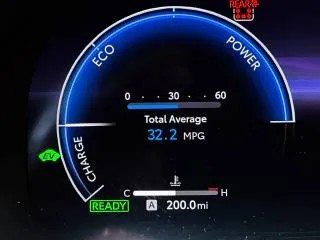For families seeking a spacious and versatile three-row SUV, the 2023 Toyota Highlander Hybrid emerges as a compelling option, particularly when fuel efficiency is a top priority. In a segment where gas mileage often takes a backseat to size and power, the Highlander Hybrid sets a new benchmark, leaving competitors struggling to keep pace. This review delves into the key aspects of the 2023 Toyota Highlander Hybrid, highlighting its exceptional fuel economy and other notable features, while also addressing areas where it could be improved.
The Toyota Highlander has long been a popular choice in the midsize SUV category, and the hybrid variant elevates its appeal by delivering impressive MPG figures without compromising on practicality. The 2023 model year sees a powertrain shift, replacing the V-6 engine with a turbo-4 in the standard Highlander. However, for those prioritizing fuel savings, the hybrid powertrain remains the smarter choice, offering significantly better mileage than either engine option in the non-hybrid model. While the standard engine options achieve around 24 mpg combined, the Highlander Hybrid boasts an EPA combined rating of 35 mpg, a figure that truly stands out in the three-row SUV landscape.
Exceptional Fuel Economy: A Clear Advantage
The heart of the Highlander Hybrid’s appeal lies in its fuel efficiency. The powertrain, featuring a 2.5-liter inline-4 engine paired with an electric motor, produces a combined 243 horsepower. While horsepower figures might not be class-leading, the real story is the MPG. The EPA estimates are remarkable for a vehicle of this size: 35 mpg city, 34 mpg highway, and 35 mpg combined. Real-world testing further validates these claims. In mixed suburban driving conditions, the reviewer observed an average of 27.7 mpg, and even during a 200-mile highway trip maintaining speeds above 70 mph, the Highlander Hybrid still achieved 32.2 mpg. While slightly below EPA estimates, these figures remain exceptionally strong, especially considering the driving conditions and vehicle type.
When comparing the Highlander Hybrid to its non-hybrid rivals, the fuel efficiency gap becomes even more pronounced. The V-6 powered Honda Pilot, for instance, manages only 19 mpg city, 25 mpg highway, and 21 mpg combined with AWD. Even the Ford Explorer Hybrid, while offering a hybrid option, falls short with an EPA rating of 23 mpg city, 26 mpg highway, and 25 mpg combined with AWD, and its powertrain is noted to be less refined. The Toyota Highlander Hybrid, therefore, confidently claims the top spot in fuel efficiency within its competitive set.
Digital Gauge Cluster and User-Friendly Controls: Modern Touches
Beyond fuel efficiency, the 2023 Highlander Hybrid offers other appealing features. Platinum and Limited trims now feature a clean and functional 12.3-inch digital gauge cluster. While not as visually adventurous as some digital clusters in other vehicles, it provides essential information, including fuel economy data and audio source, in an easily digestible format. Toyota also deserves credit for retaining physical buttons and knobs for climate control. In an era of increasingly screen-dependent interiors, the tactile controls in the Highlander Hybrid offer a welcome and intuitive user experience. The ease of adjusting temperature or fan speed without navigating through menus is a practical advantage appreciated by drivers.
Drawbacks: Volume Knob Placement, Running Boards, and Infotainment Changes
Despite its strengths, the 2023 Toyota Highlander Hybrid is not without its drawbacks. One peculiar design choice is the relocation of the volume knob in the top-tier Limited and Platinum trims. Positioned on the passenger side of the 12.3-inch touchscreen, it becomes an inconvenient reach for the driver. While steering wheel controls offer an alternative, they require multiple clicks for volume adjustments, making quick changes less seamless compared to a traditional knob.
Another questionable feature, at least in its execution on the tested Platinum model, is the optional running boards. Priced at $599, these running boards were deemed unhelpful, even hindering entry and exit for both adults and children. With a ground clearance of 8.0 inches, the Highlander Hybrid is not particularly tall, rendering the running boards unnecessary and obstructive. Prospective buyers should carefully consider their utility before opting for this accessory.
Finally, the infotainment system in the 2023 Highlander Hybrid has undergone changes that are not entirely positive. While the screen size remains 12.3 inches in higher trims, the split-screen functionality of the previous system has been removed. The new Toyota operating system, also found in the Tundra and Sequoia, occupies the entire display, whether running Apple CarPlay, maps, or other functions. This single-screen approach diminishes the utility of the large display, as the ability to view multiple information sources simultaneously is lost. The removal of physical media source buttons further necessitates screen interaction for functions that were previously more readily accessible.
Conclusion: Fuel Efficiency Champion with Minor Trade-offs
The 2023 Toyota Highlander Hybrid firmly establishes itself as a leader in fuel efficiency within the three-row SUV segment. Its exceptional MPG figures provide a significant advantage over competitors, making it an attractive choice for families seeking to minimize fuel costs without sacrificing space and versatility. While some aspects, such as the volume knob placement, running boards, and infotainment system changes, present minor drawbacks, they are overshadowed by the compelling fuel economy and overall user-friendliness of the vehicle. For buyers prioritizing fuel efficiency in a three-row SUV, the Toyota Highlander Hybrid remains the top contender and a highly recommended option.
––––––––––––––––––––––––––––––––––––––––––
2023 Toyota Highlander Hybrid
Base price: $37,635, including $1,335 destination
Price as tested: $55,647
Powertrain: 243-hp hybrid, all-wheel drive
EPA fuel economy: 35/34/35 mpg
The hits: Great fuel economy, easy to live with
The misses: Volume knob placement, useless running boards, infotainment system became less functional
